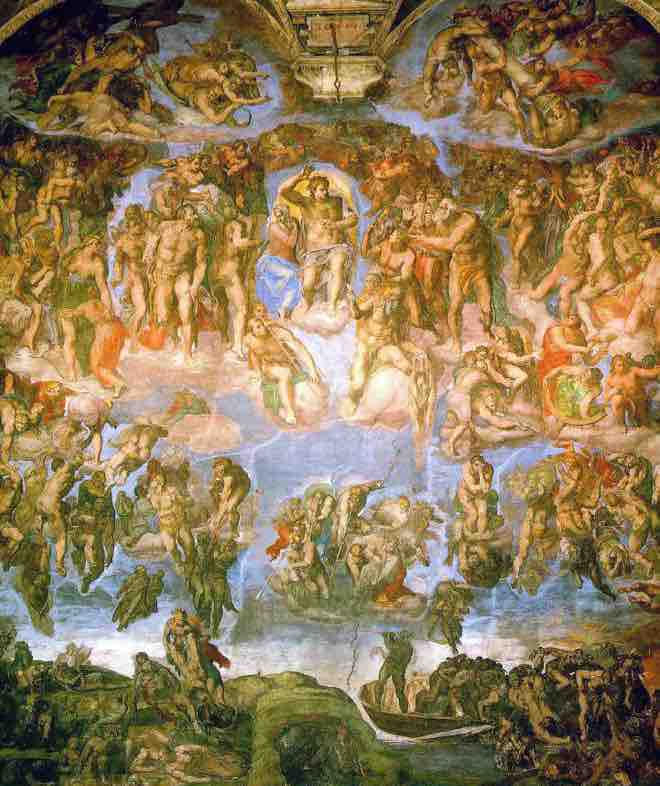Italian Painting and Mannerism
Italian Renaissance painting after 1520 developed certain characteristics that are considered Mannerist, such as elongated forms and irrational settings. Mannerism, as well as works from the High Renaissance, concerned many Catholic leaders in the wake of the Reformation, as they were seen as lacking pious appeal. Furthermore, a great divergence had arisen between the Catholic Church and Protestant reformers of Northern Europe regarding the content and style of art work.
Church pressure to restrain religious imagery affected art from the 1530s and influenced several decrees from the final session of the Council of Trent in 1563. These decrees included short passages concerning religious images that had significant impact on the development of Catholic art during the Counter-Reformation. The Church felt that religious art in Catholic countries (especially Italy) had lost its focus on religious subject matter. It focused on decorative qualities instead, with heavy influences from classical, pagan art, leading to a church decree that "art was to be direct and compelling in its narrative presentation, that it was to provide an accurate presentation of the biblical narrative or saint's life, rather than adding incidental and imaginary moments, and that it was to encourage piety" (Paoletti and Radke, Art in Renaissance Italy). The reforms that resulted from this council are what set the basis for Counter-Reformation art.
The Counter-Reformation Movement
While the Protestants largely removed public art from religion and moved towards a more "secular" style of art, embracing the concept of glorifying God through depictions of nature, the Counter-Reformation Catholic Church promoted art with "sacred" or religious content. In other words, art was to be strictly religious, created for the purpose of glorifying God and Catholic traditions.
To that end, The Last Judgment, a fresco on the altar wall of the Sistine Chapel by Michelangelo (1534–41), came under attack for its classical imagery and the large quantity of nudes, some of which were interpreted at the time as being in compromising poses. The Last Judgment was an object of dispute between critics within the Catholic Counter-Reformation and those who appreciated the genius of the artist and the Mannerist style of the painting. Michelangelo was accused of being insensitive to proper decorum, and of flaunting personal style over appropriate depictions of content. The fresco was also completed at a time when prints could be made of the work and distributed throughout Northern Europe, the base for criticisms against the Catholic Church. While Michelangelo had been celebrated during the Renaissance for his classical influence and depictions of monumental nudes in a variety of poses, here he was being criticized for The Last Judgment. Michelango was not doing anything new or different from his previous style, which had been celebrated in the past. This demonstrates how the historical situation had altered and just how threatened the Catholic Church felt at this time in history.

The Last Judgement
The Last Judgment fresco in the Sistine Chapel by Michelangelo (1534–41) came under persistent attack in the Counter-Reformation for nudity (later painted over for several centuries), not showing Christ seated or bearded, and including the pagan figure of Charon.
Scipione Pulzone's painting of the Lamentation, commissioned for the Gesu Church in 1589, gives a clear demonstration of what the Council of Trent was striving for in the new style of religious art. With the focus of the painting giving direct attention to the crucifixion of Christ, it complies with the religious content of the council and shows the story of the Passion while keeping Christ in the image of the ideal human.

Lamentation
Scipione Pulzone's Lamentation, a pious depiction of the Crucifixion, embodied a typical Counter-Reformation work.
On the other hand, in Paolo Veronese's painting The Last Supper (subsequently renamed The Feast in the House of Levi), one can see what the Council regarded as inappropriate. Veronese was summoned before the Inquisition on the basis that his composition was indecorous for the refectory of a monastery. The painting shows a fantasy version of a Venetian patrician feast, with, in the words of the Inquisition: "buffoons, drunken Germans, dwarfs and other such scurrilities" as well as extravagant costumes and settings. Veronese was told that he must change his painting within a three-month period; instead he simply changed the title to The Feast in the House of Levi .

Last Supper/House of Levi
Paolo Veronese was accused of being indecorous for the refectory of a monastery in his Last Supper (The Feast in the House of Levi).